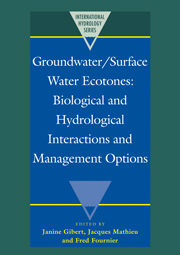Book contents
- Frontmatter
- Contents
- List of authors
- Preface
- I INTRODUCTION
- II FUNCTION OF GROUNDWATER / SURFACE WATER INTERFACES
- III MALFUNCTION OF GROUNDWATER / SURFACE WATER INTERFACES: CAUSES AND METHODS OF EVALUATION
- IV MANAGEMENT AND RESTORATION OF GROUNDWATER / SURFACE WATER INTERFACES
- 24 Ecotones and problems of their management in irrigation regions
- 25 Hydrochemistry and ecohydrology of the transition area of the Netherlands Delta and the Brabantse Wal
- 26 Cautious reforestation of a wetland after clearfelling
- 27 Responses of riparian ecosystems to dewatering of the Aral Sea in the vicinity of the Tedgen and Murgab rivers
- 28 Water regime management of desertificated ecotone systems in the Amudarya delta (Aral Sea basin)
- V CONCLUSION
- ANNEX
25 - Hydrochemistry and ecohydrology of the transition area of the Netherlands Delta and the Brabantse Wal
Published online by Cambridge University Press: 07 September 2010
- Frontmatter
- Contents
- List of authors
- Preface
- I INTRODUCTION
- II FUNCTION OF GROUNDWATER / SURFACE WATER INTERFACES
- III MALFUNCTION OF GROUNDWATER / SURFACE WATER INTERFACES: CAUSES AND METHODS OF EVALUATION
- IV MANAGEMENT AND RESTORATION OF GROUNDWATER / SURFACE WATER INTERFACES
- 24 Ecotones and problems of their management in irrigation regions
- 25 Hydrochemistry and ecohydrology of the transition area of the Netherlands Delta and the Brabantse Wal
- 26 Cautious reforestation of a wetland after clearfelling
- 27 Responses of riparian ecosystems to dewatering of the Aral Sea in the vicinity of the Tedgen and Murgab rivers
- 28 Water regime management of desertificated ecotone systems in the Amudarya delta (Aral Sea basin)
- V CONCLUSION
- ANNEX
Summary
ABSTRACT
Groundwater/surface water interactions are often characterised by hydrological and hydrochemical processes which result in complex abiotic and biotic gradients. Therefore a study was made of the hydrochemistry and ecohydrology of a groundwater discharge area in a low coastal area, lying in front of a higher sandy recharge area in the southwest of the Netherlands.
A hydrochemical facies analysis was applied to identify and map the major factors accounting for variations in hydrochemical processes. Research was concentrated in a relatively small fresh water upwelling zone in the discharge area, to obtain insight into the actual interrelationship between groundwater, surface water, aquatic ecology and human influence. During 1992 surface water samples and groundwater samples were taken along four regional transects. In the upwelling zone, sampling of shallow groundwater and surface water was combined with detailed mapping of aquatic vegetation. In total, 43 species were found and over 275 water samples were analysed in the laboratory. The two main water systems, the Brabantse Wai hydrosome and the polder hydrosome, are described by seven chemical watertypes, redox potential index, eutrophication potential index and calcite saturation index. The regionally derived maps of ground and surface water quality correspond fairly accurately. In the fresh water upwelling zone four types of aquatic vegetation (noda) have been discerned. Each nodum has distinct ecological amplitudes for alkalinity, pH and salinity of the surface water. These do not match general indicative values for the Netherlands, as described in literature. The hydrochemical characteristics of the ground and surface water in the upwelling zone deviate to a large extent. This points to an increasing contribution of polluted groundwater from a shallow groundwater flow system.…
- Type
- Chapter
- Information
- Groundwater/Surface Water EcotonesBiological and Hydrological Interactions and Management Options, pp. 194 - 203Publisher: Cambridge University PressPrint publication year: 1997

